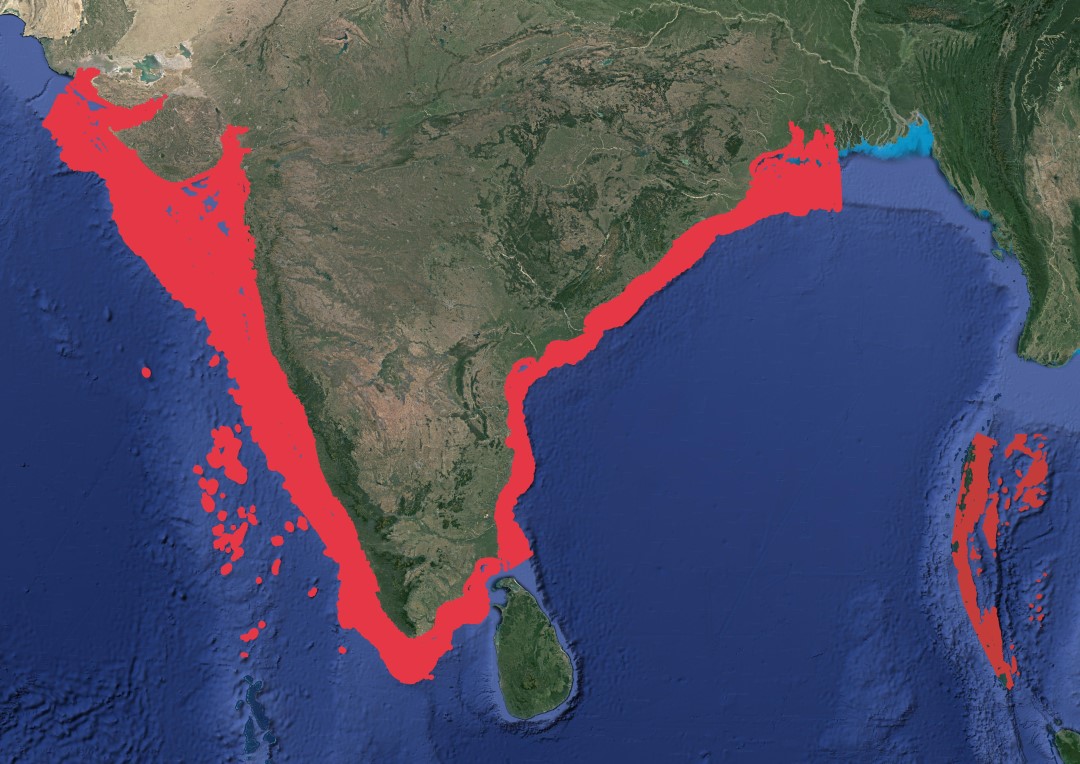Species Name
Tiger Shark
Scientific Name
Galeocerdo cuvier
Family Name
Carcharhinidae
IUCN Status
Near Threatened
Body is grey with dark grey vertical bars or spots on the flanks with a pale or white underside. The markings are very distinctive on juveniles but become lighter with age. Snout is blunt and wide, with large eyes.
Biology
Length: Tiger sharks are one of the largest shark species, with adult individuals typically ranging from 10 to 14 feet (3 to 4.3 meters) in length. However, some individuals can reach up to 18 feet (5.5 meters) or more, making them formidable apex predators in their ecosystems.
Gestation period: 13 to 16 months
Littter size: Tiger sharks are known to have relatively large litters. A typical litter can contain anywhere from 10 to 80 pups, with an average of around 30 to 40 pups.
Life Expectancy: The life expectancy of tiger sharks in the wild is estimated to be around 20 to 30 years. Maximum reported age is 50 years.
Diet: Tiger sharks are opportunistic and highly versatile predators, earning them a reputation as "garbage cans of the sea" due to their diverse diet. They are known to consume a wide range of prey, including fish, marine mammals, seabirds, crustaceans, and even other sharks. Their diet often includes carrion and scavenged items, which contributes to their adaptability as apex predators.
Habitat and Distribution
Habitat: Tiger sharks are highly adaptable and can be found in a wide range of marine habitats. They are known to inhabit both coastal and offshore waters. These sharks can be seen in shallow waters close to shore, but they are also capable of venturing into deep oceanic environments. Tiger sharks prefer warm waters, and they are often found in tropical and subtropical regions. They are known for their ability to tolerate a wide range of salinities, which allows them to inhabit areas with varying degrees of salt concentration, such as estuaries and lagoons.
Distribution: The tiger shark has a global distribution, occurring in both coastal and open ocean environments. They are found in a wide range of oceans, including the Atlantic, Indian, and Pacific oceans. Tiger sharks are commonly found in the waters of the United States, particularly in the Gulf of Mexico and off the southeastern coast. They are also abundant in the Caribbean Sea, off the coasts of Australia, Africa, and throughout the Indo-Pacific region.
Known landing centres: Digha Mohana, Mookaiyur Fisheries Harbour, Royapuram Fishing Harbour, Cuddalore Fishing Harbour, Nagapattinam Fishing Harbour, Cochin Fisheries Harbour, Junglighat, Burma Nallah and Pentakota.
Depth: Tiger sharks are known to occupy a wide range of water depths. They can be found in shallow coastal waters, near shorelines, and in the open ocean, making them a highly versatile species. While tiger sharks are often seen in depths of around 3 to 20 meters (10 to 65 feet), they are capable of diving much deeper. Some studies have recorded tiger sharks at depths of over 800 meters (2,625 feet), demonstrating their ability to venture into the mesopelagic zone.
Commercial Value
They're targeted for their fins, flesh, and oil and indirectly as bycatch in commercial and recreational fisheries worldwide. Historically, tiger shark liver was used to produce oil rich in vitamin A whereas the thick, tough skin was used for producing quality leather.
Threats
Immense fishing pressure and being caught as bycatch in the seamount gillnet and longline fishery off the west coast of India. One of the major threats is the unreported catch data from various areas with high level of fishing pressure.
References
- Compagno, L.J.V., (1984). FAO Species Catalogue. Vol. 4. Sharks of the world. An annotated and illustrated catalogue of shark species known to date. Part 2 - Carcharhiniformes. FAO Fish. Synop. 125(4/2):251-655. Rome: FAO.
- Holland, K. & Wetherbee, Bradley & Lowe, Christopher & Meyer, Carl. (1999). Movements of tiger sharks (Galeocerdo cuvier) in coastal Hawaiian waters. Marine Biol. 134. 665-673. 10.1007/s002270050582.
- M., H., L., D., G., M., & B., B. (2002). Habitat use and foraging behavior of tiger sharks ( Galeocerdo cuvier ) in a seagrass ecosystem. Marine Biology, 140(2), 237–248. https://doi.org/10.1007/S00227-001-0711-7
- Simpfendorfer, C et al (2001). Size, Sex And Geographic Variation in the Diet of the Tiger Shark, Galeocerdo Cuvier, From Western Australian Waters. Environmental Biology of Fishes. 61. 10.1023/A:1011021710183.


Related Species
- Silky Shark
- Blacktip Reef Shark
- Common Blacktip Shark
- Spot-tail Shark
- Milk Shark
- Spadenose Shark
- Bignose Shark
- Blackspot Shark
- Blue Shark
- Broadfin Shark
- Bull Shark
- Dusky Shark
- Ganges Shark
- Graceful Shark
- Grey Reef Shark
- Grey Sharpnose Shark
- Hardnose Shark
- Sliteye Shark
- Silvertip Shark
- Sharptooth Lemon Shark
- Sandbar Shark
- Pondicherry Shark
- Pigeye Shark
- Oceanic Whitetip Shark
- Irrawaddy River Shark
- Speartooth Shark
- Spinner Shark
- Whitecheek Shark
- Whitetip Reef Shark

